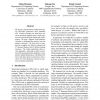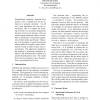444 search results - page 4 / 89 » Evaluating and Combining Approaches to Selectional Preferenc... |
COGSCI
2002
13 years 7 months ago
2002
Selectional preferences have a long history in both generative and computational linguistics. However, since the publication of Resnik's dissertation in 1993, a new approach ...
VLDB
2004
ACM
14 years 24 days ago
2004
ACM
Declarative queries are proving to be an attractive paradigm for interacting with networks of wireless sensors. The metaphor that “the sensornet is a database” is problematic,...
EMNLP
2008
13 years 9 months ago
2008
We present a discriminative method for learning selectional preferences from unlabeled text. Positive examples are taken from observed predicate-argument pairs, while negatives ar...
NLE
2010
13 years 5 months ago
2010
Distributional similarity methods have proven to be a valuable tool for the induction of semantic similarity. Up till now, most algorithms use two-way cooccurrence data to compute...
CORR
2006
Springer
13 years 7 months ago
2006
Springer
Through the Internet and the World-Wide Web, a vast number of information sources has become available, which offer information on various subjects by different providers, often i...


